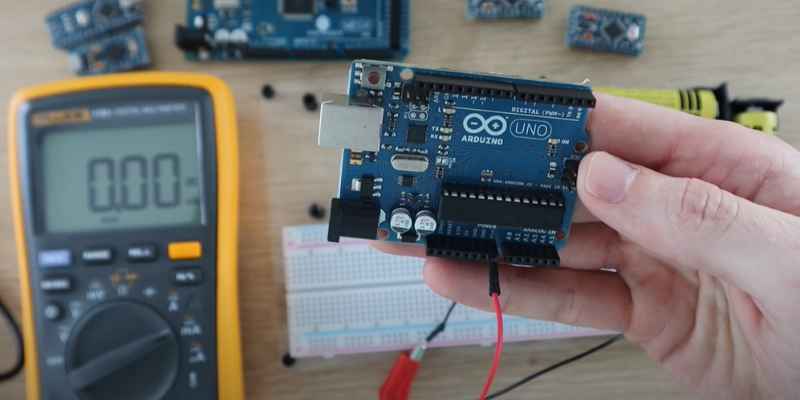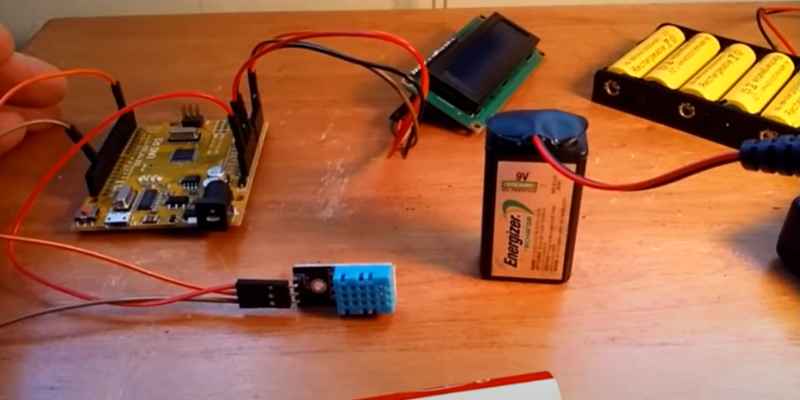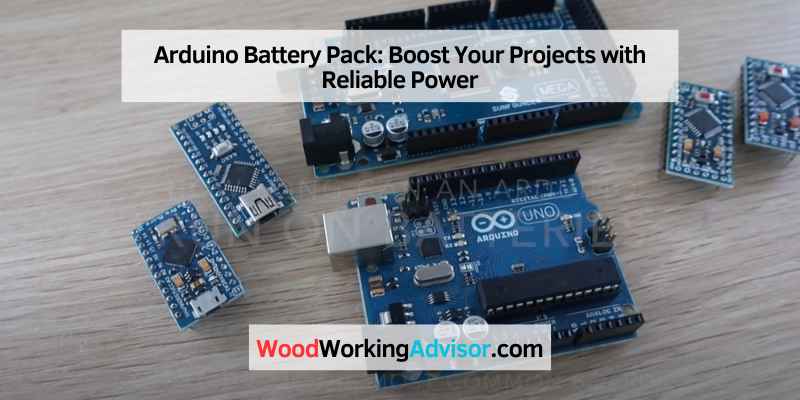An Arduino battery pack is a portable power source for Arduino microcontrollers, providing convenience and flexibility. With multiple applications in electronics and robotics projects, these battery packs enable uninterrupted operation and improve device portability.
Arduino battery packs are an essential accessory for powering Arduino boards in remote locations or when access to a power outlet is limited. These compact and lightweight packs are designed to deliver the necessary voltage and current requirements for optimal functionality.
They often have built-in charging circuits, allowing for easy recharging, and may include features like voltage and current monitoring. By using an Arduino battery pack, users can ensure consistent and reliable power supply, making them an indispensable component in various projects and applications.

Understanding Arduino Battery Packs
Arduino battery packs are essential components that provide power to Arduino boards, enabling them to function independently without a direct power source.
Benefits Of Using Arduino Battery Packs
- Ensures portability of Arduino projects
- Reduces dependency on power outlets
- Facilitates outdoor and remote applications
Types Of Battery Packs Compatible With Arduino Boards
| Battery Type | Features |
|---|---|
| Lithium-ion | High energy density and long lifespan |
| AAA battery pack | Common, easily replaceable, and affordable |
| LiPo battery | Lightweight, suitable for small form factor projects |
Factors To Consider
Choosing the right battery pack for your Arduino project is crucial in ensuring smooth operation and reliable power supply. Several factors need to be taken into consideration to make an informed decision that matches your project’s requirements. In this article, we will discuss the three main factors to consider when selecting an Arduino battery pack: voltage requirements, capacity, and discharge rate.
Voltage Requirements For Arduino Projects
The first factor to consider is the voltage requirements for your Arduino project. Arduino boards typically operate at 5 volts, but it’s crucial to check the specific voltage requirements of the components you will be using. Some shields or modules may require a different voltage, such as 3.3 volts. It’s essential to choose a battery pack that can provide the necessary voltage level for your entire project to function correctly.
Capacity And Discharge Rate Considerations
Capacity and discharge rate are two crucial factors when it comes to choosing an Arduino battery pack. Capacity refers to the amount of charge the battery can store, which is typically measured in milliampere-hours (mAh). Higher capacity batteries will provide longer operation times but may be physically larger and heavier.
The discharge rate, or the maximum current that the battery can deliver, is equally important. Arduino projects with power-hungry components like motors or LEDs will require a battery pack with a higher discharge rate to handle the current demands. Ensure that the selected battery pack can deliver the necessary current without overheating or voltage drop, which can lead to unreliable performance.
Consider the following table as a summary of the main factors:
| Factor | Considerations |
|---|---|
| Voltage Requirements | Check the specific voltage requirements of your Arduino components |
| Capacity | Choose a battery pack with sufficient mAh capacity for your project’s runtime needs |
| Discharge Rate | Select a battery pack that can handle the maximum current demands of your project’s components |
By considering the voltage requirements, capacity, and discharge rate of the battery pack, you can ensure that your Arduino project operates smoothly and reliably. Keep these factors in mind when choosing the right battery pack for your specific project needs.
Choosing The Right Battery Pack
Choosing the right battery pack for your Arduino project is crucial for ensuring optimal performance and longevity. With a wide array of options available, it’s important to consider various factors in order to determine the most suitable battery pack for your specific needs.
Comparing Different Battery Chemistries
When selecting a battery pack for your Arduino project, it’s essential to consider the different battery chemistries available. Each type of battery chemistry has its own unique characteristics and is best suited for specific applications.
Factors Influencing The Selection Process
Several factors influence the selection process when choosing a battery pack for your Arduino. By considering these factors, you can ensure that the chosen battery pack meets the requirements of your project and provides optimal performance.
In the section about “Comparing different battery chemistries,” you may want to add a table to visually compare the different battery chemistries, followed by a brief description of each type. For “Factors influencing the selection process,” you can create a bulleted or numbered list to outline the various factors to consider.
Optimizing Power Consumption
Optimizing power consumption is crucial when working with Arduino battery packs to ensure efficient and long-lasting performance. Implementing power-saving strategies can extend the battery life of Arduino projects, making them more sustainable and cost-effective.
Implementing Power-saving Strategies In Arduino Projects
When working on Arduino projects, optimizing power consumption is essential for prolonging battery life. By implementing power-saving strategies, you can ensure that your projects operate efficiently without excessive power consumption. Some key strategies include:
- Utilizing low-power components and sensors
- Implementing sleep modes to reduce idle power consumption
- Optimizing code to minimize unnecessary processing
- Using efficient power management techniques for peripherals
Tips For Efficient Power Management
Efficient power management is vital to maximize the longevity of Arduino battery packs. To achieve this, consider the following tips for optimizing power consumption:
- Choose an appropriate battery capacity for your project’s requirements
- Utilize power-efficient coding practices to minimize energy usage
- Employ hardware optimizations to reduce power consumption during operation
- Regularly monitor and analyze power consumption to identify potential areas for improvement

Safety Measures
Safety measures are essential when working with Arduino battery packs to prevent accidents and protect your valuable Arduino board. By following proper handling and charging precautions for battery packs and taking steps to safeguard your Arduino board from power-related issues, you can ensure a safe and reliable electronics project.
Handling And Charging Precautions For Battery Packs
When it comes to handling and charging battery packs for your Arduino projects, it’s important to keep these precautions in mind:
- Use batteries with caution: Always handle batteries with care and avoid short-circuiting them. Incorrect usage can lead to overheating, leakage, or even explosion.
- Follow manufacturer guidelines: Read the manufacturer’s instructions and guidelines for the specific battery pack you are using. Different battery types may have different charging requirements.
- Use a compatible charger: Ensure that the charger you use is compatible with the battery pack and follows the recommended voltage and current specifications. Using an incompatible charger can damage the batteries or pose a safety risk.
- Never leave batteries unattended while charging: It is essential to supervise the charging process, especially for lithium-ion batteries. Overcharging or charging in an inappropriate temperature environment can lead to battery damage or even fire.
Protecting Your Arduino Board From Power-related Issues
To safeguard your Arduino board and prevent power-related issues, consider the following:
- Install a voltage regulator: Adding a voltage regulator circuit to your Arduino project can prevent sudden voltage spikes or drops, protecting your board from potential damage.
- Use a surge protector: Connecting your Arduino board to a surge protector can help shield it from power surges and electrical fluctuations. This is particularly important when working in areas with an unstable power supply.
- Utilize an external power supply: Instead of relying solely on the battery pack, consider incorporating an external power supply to ensure a stable and continuous source of power for your Arduino board.
By following these safety measures, you can enjoy smooth and secure operation of your Arduino projects without compromising the integrity of your board or risking any potential hazards.
Diy Battery Pack Projects
Discover the endless possibilities of powering your Arduino projects with custom battery packs.
Building Custom Battery Packs For Specific Arduino Applications
Customize your power solution to fit unique Arduino project needs.
Exploring Advanced Power Supply Solutions
Ensure reliable and efficient power delivery for your Arduino creations.
Frequently Asked Questions For Arduino Battery Pack
What Are The Benefits Of Using An Arduino Battery Pack?
An Arduino battery pack provides portability and flexibility for your projects, allowing them to be used in remote locations without the need for a power outlet. It also offers a reliable power source, ensuring uninterrupted operation of your Arduino devices.
How To Choose The Right Battery Pack For Arduino?
Consider factors such as voltage and capacity requirements, size and weight constraints, and the intended usage environment when selecting an Arduino battery pack. Ensure compatibility and safety with your specific Arduino model, and opt for high-quality, reputable brands for reliability.
What Type Of Batteries Are Compatible With Arduino?
Common battery types compatible with Arduino include AA, AAA, and lithium-ion cells. Rechargeable batteries such as LiPo and Li-ion offer cost-effective and eco-friendly solutions, while alkaline batteries provide a convenient disposable power source for temporary applications.
Can I Use Multiple Battery Packs To Power My Arduino Project?
Yes, multiple battery packs can be connected in series or parallel to increase voltage or capacity, respectively. However, be mindful of balancing the load and managing the overall power system to ensure the safe and efficient operation of your Arduino project.
Conclusion
To sum up, an Arduino battery pack is a crucial component for powering your Arduino projects conveniently and efficiently. With its portable design and long-lasting battery life, it ensures uninterrupted operation, making it ideal for various applications. By choosing the right Arduino battery pack, you can enhance the functionality and mobility of your projects.
So, why wait? Invest in an Arduino battery pack today and take your projects to new heights!


